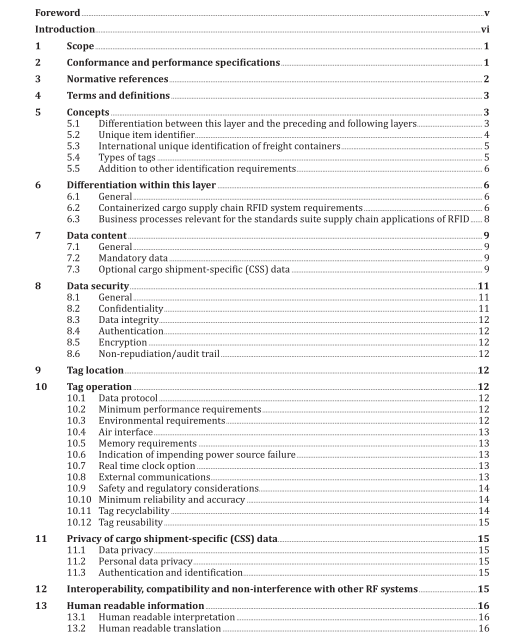BS ISO 17363:2013 pdf download.Supply chain applications of RFID — Freight containers
This International Standard defines the usage of read/write radio-frequency identification technology (RFID) cargo shipment-specific tags associated with containerized freight for supply chain management purposes (“manifest tags”). This International Standard defines the air interface communications, a common set of required data structures, and a commonly organized, through common syntax and semantics, set of optional data requirements.
This International Standard:
— makes recommendations about a second generation supply chain tag intended to monitor the condition and security of the freight resident within a freight container;
— specifies the implementation of sensors for freight resident in a freight container;
— makes specific recommendations about mandatory non-reprogrammable information on the shipment tag;
— makes specific recommendations about optional, re-programmable information on the shipment tag;
— makes specific recommendations about the data link interface for GPS or GLS services;
— specifies the reuse and recyclability of the RF tag;
— specifies the means by which the data in a compliant RF tag is “backed-up” by bar codes and twodimensional symbols, as well as human-readable information.
2 Conformance and performance specifications
The underlying conformance requirements of this International Standard are to provide the structure necessary to raise the level of interoperability of components and systems built according to this International Standard, while leaving open opportunity for continued technical improvement and differentiation.
Implementation of a containerized cargo supply chain RFID system and its components shall be deemed in conformance with this International Standard if it meets, and supports, the following six requirements:
a) the required functional performance specified in Clause 6;
b) the data requirements specified in Clause 7;
c) the data security requirements specified in Clause 8;
d) the tag location requirements specified in Clause 9;
e) the tag operation requirements specified in Clause 10;
f) the security and privacy requirements specified in Clause 11.
3 Normative references
The following referenced documents are Indispensable foi the application of this document. For dated references, only the edition cited applies. For undated references, the latest edition of the relerenced document (induding any amendments) applies.
ISO 6346:1995, Freight containers — Coding. identification and marking
ISO 8601. Data elements and interchange formats — Information interchange — Representation of dates and times
ISO/IEC/IEEE 8802-15-4. Information technolog>’ — Telecommunications and information exchange between systems — Local and metropolitan area networks — Specific requirements — Part 15.4: Wireless medium access control (MAC) and physical layer (P1W) .specificatuins for low-rate wlreles.s personal area networks (WPANs)
ISO 10374:1991, Freight containers — Automatic identification
ISO/IEC 15418, Information technology — Automatic identification and data capture techniques — GSI Application Identifiers and ASC MHIO Data Identifiers and maintenance
ISO/IEC 15434. InformatIon technology — Automatic identification and data capture tehniques — Syntax ft,rhigh.capacityADC media
ISO/IEC 15459 (all parts). Information technology — Automatic identification and data capture techniques — Unique identification
ISO/IEC 15961. Information technology — Radio frequency identification (RFID) for Item management — Data protocol: application interface
ISO/IEC 15962. information technology — Radio frequency identification (RF1D) for item management — Data protocol: data encoding rides and logical memory functions
ISO/I F.C 15963, Information technology — Radio frequency identification far Item maitogement — Unique identification for Rftags
ISO 17364:2013. Supply chain appilcation.c of RFID — Returnable transport ltem.s (RTIs)
ISO/I F.C 18000-7. Information technology — Radio frequency identification for Item snanciqement — Part 7:
Parameters foractive air interface communicot ions at 433 MHz
ISO/IF.C 18046, InformatIon technology — Automatic Identification and data capture techniques — Radio frequency identification device performance test methods
ISO/IEC 19762 (all parts), Jnformut Ion technology — Automatic identification and data capture (AIDC) techniques — Harmonized vocabulary
ISO/IEC/IEEE 21451S [IEEE 1451.5]. Information technology — Smart Transducer Interface for Sensors and Actuators — Wireless Communication Protocols and Transducer Electronic Data Sheet (TEDS) Formats
ISO/I EC/IEEE 21451-7. information technology — Smart transducer interface for sensors and actuators — Part 7: Transducer to radio frequency identification (RF1D)systems communication protocols and Transducer
Electronic Data Sheer (TEDS) formats
IF.C 61000-4-2. Electromagnetic compatibility (EMC) — Part 4-2: TestIng and measurement techniques — Elect rust utfc discharge immunity test
IEC 61000-4-3:2006, Electromagnetic compatibility (EMC) — Purr 4-3: Testing and meusiirrmcut techniques — Radiated. radio•frequencv elect romagnetic field immunity test.BS ISO 17363 pdf downlaod.ISO 17363-2013 pdf download
